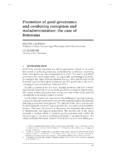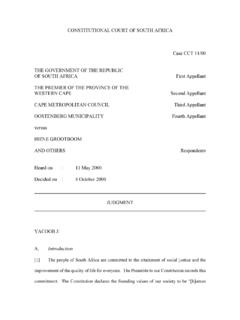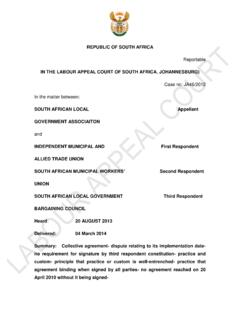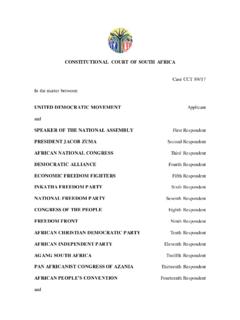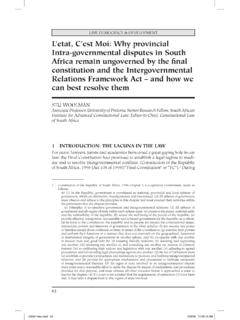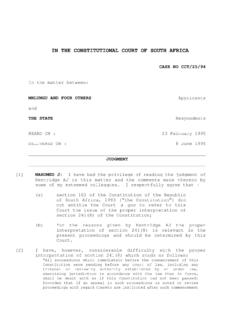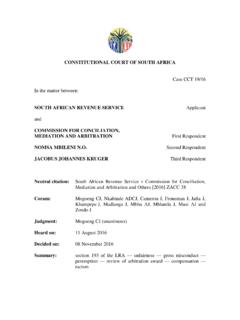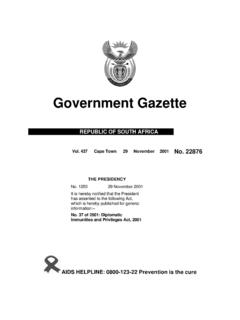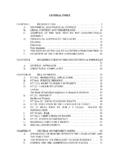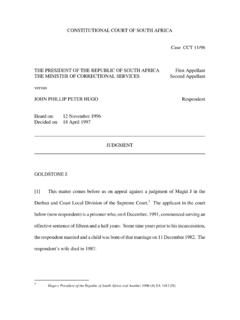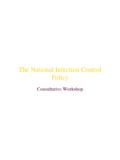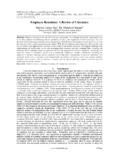Transcription of REPORTABLE - SAFLII
1 Republic of South Africa IN THE HIGH COURT OF SOUTH AFRICA. (EASTERN CIRCUIT LOCAL DIVISION). REPORTABLE . CASE No: 17318/2009. In the matter between: ERICA SCHREPFER Plaintiff and HEINZ GUNTHER PONELAT Defendant _____. JUDGMENT DELIVERED : 26 AUGUST 2010. _____. __. MOOSA, J: Introduction: [1] In this matter the Plaintiff instituted action against the Defendant in terms of which she sought relief in respect of two claims. The first claim is for a declaration that a universal partnership existed between the Plaintiff and the Defendant, confirming the dissolution of such partnership and claiming certain consequential relief. In the alternative to the first claim, she claimed from the Defendant maintenance at the rate of R12 000 per month until her death, remarriage or permanent co-habitation with a partner.
2 The first claim is premised on an oral agreement, alternatively on an implied E Schrepfer v H G Ponelat Cont/ . 2. and/or tacit agreement based on their conduct. The second claim is for damages in the sum of R100 000 for breach of promise to marry and for certain ancillary relief. The Defendant opposed the action and, in his plea, denied that a universal partnership existed between him and the Plaintiff and denied that he had promised to marry the Plaintiff. The Issues: [2] In terms of the pleadings, the issues the court is called upon to determine in respect of the first claim are whether a universal partnership existed between the parties and if it is found that a universal partner existed, the court must make a pronouncement on the consequential relief sought by the Plaintiff.
3 However, should the court find that a universal partnership did not exist, then the court must adjudicate the alternative claim of whether the Plaintiff is entitled to the payment of maintenance from the Defendant and if so, what is an appropriate amount. The issues the court has to determine in respect of the second claim are whether the Defendant promised to marry the Plaintiff and if so, whether there was a breach, and if there was a breach whether the breach was wrongful. If it is found that there was no promise to marry, or there was no breach or the breach was not wrongful, the Plaintiff cannot succeed. If on the other hand all those elements are established, before the court can award damages, the Plaintiff must establish the impairment of the dignitas.
4 The Law: [3] The essentials of a special contract of partnership were confirmed in the case of Pezzuto v Dreyer 1992 (3) SA 379 (A) at 390, as follows: Our courts have accepted Pothier's formulation of such essentials as a correct statement of the law (Joubert v Tarry & Co 1915 TPD 277 at E Schrepfer v H G Ponelat Cont/ . 3. 280-1; Bester v Van Niekerk 1960 (2) SA 779 (A) at 783H-784A;. Purdon v Muller 1961 (2) SA 211 (A) at 218B-D). The three essentials are (1) that each of the partners bring something into the partnership, whether it be money, labour or skill; (2) that the business should be carried on for the joint benefit of the parties; and (3) that the object should be to make a profit (Pothier: A Treatise on the Contract of Partnership (Tudor's translation) ).
5 A fourth requirement mentioned by Pothier is that the contract should be a legitimate one.. [4] The essentiala of the partnership set out above applies equally to a universal partnership. In this regard see Muhlmann v Muhlman 1981 (4) SA 632 (W) ; V(aka)L. v De Wet N O 1953 (1) SA 612 (O) at 615; Isaacs v Isaacs 1949 (1) SA 952 (C) at 956. and Schaeffer: Butterworths Family Law: Cohabitation at page 3). The contract of partnership may not necessarily be expressed. It could be tacit or implied from the facts, provided they admit of no other conclusion than that the parties intended to create a partnership (Festus v Worcester Municipality 1945 CPD 186 (C).
6 Our courts have recognised that a universal partnership, also known as domestic partnership, can come into existence between spouses and co-habitees where they agree to pool their resources (Muhlmann v Muhlmann 1984 (3) 102 (A); Kritzinger v Kritzinger 1989 (1). SA 67 (A); Ally v Dinath 1984 (2) SA 451 (T) and V(aka) L v De Wet (supra)). The Universal Partnership: [5] Our common law recognises two types of universal partnerships. The one is commonly known as the universorum quae ex quaestu veniunt which Pothier, according to Tudor's translation at page 32, describes as follows: The parties thereby contract a partnership of all that they may acquire E Schrepfer v H G Ponelat Cont/.
7 4. during its continuance, from every kind of commerce. They are considered to enter into this kind of partnership when they declare that they contract together a partnership without any further explanation.. The other is commonly known as universorum bonorum which Pothier, according to Tudor's translation at page 24, describes as follows: The partnership universorum bonorum is that by which the contracting parties agree to put in common all their property, both present and future.. (See Isaacs v Isaacs 1949 (1) SA 952 (C).). [6] The present claim falls under the universorum bonorum. There has been some uncertainty firstly, whether the universorum bonorum has fallen into disuse (De Wet &.)
8 Yeats: Kontraktereg at page 381) and secondly, whether it has to be entered into expressly (Annabhay v Ramlall and Others 1960 (3) SA 802 (D)). Ellof J (as he then was), in Ally v Dinath 1984 (2) SA 451 (T) considered an exception taken to the claim for a universal partnership based on universorum bonorum on the ground that there was no allegation that the agreement of universal partnership was concluded expressly. Ellof J, accepted that our common law, in line with the decision of Searle J, in Isaacs v Isaacs (supra), recognised two types of universal partnerships, namely universorum bonorum and universorum quae ex quaesty veniunt. After analysing the various Roman- Dutch law authorities, he concluded that there is no merit in the contention that the universal partnership of the type known as universorum bonorum should be expressly entered into by the parties.
9 These decisions have been followed in a very recent case by Davis J, in Sepheri v Scanlan 2008 (1) SA 322 . I have no reason to differ from them and accordingly conclude firstly, that the universorum bonorum has not fallen in disuse and secondly that the universorum bonorum does not necessarily have to be E Schrepfer v H G Ponelat Cont/ . 5. entered into expressly. It can come into existence tacitly or by the conduct of the parties. [7] A universal or domestic partnership is akin to a marriage in community of property. H R Hahlo: The South African Law of Husband and Wife 5th edition, at pages 157-158, describes marriage in community of property as follows: Community of property is a universal economic partnership of the spouses.
10 All their assets and liabilities are merged in a joint estate, in which both spouses, irrespective of the value of their financial contributions, hold equal shares.. And on the reciprocal duty of support in a marriage, he goes on to say at page 354 as follows: Divorce puts an end to the reciprocal duty of support that existed between the spouses during marriage. An existing court order for the maintenance of the wife comes to an end. So does a clause in a separation agreement providing for the maintenance of the wife.. The Evaluation [8] With that backdrop I turn to evaluate the evidence to determine whether the Plaintiff has made out a case for the relief she is seeking.
